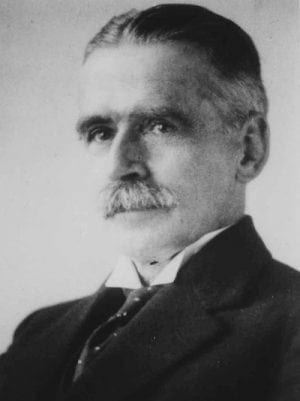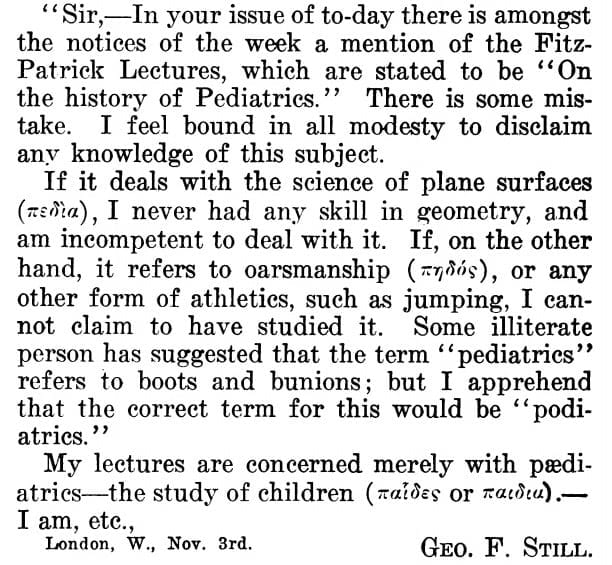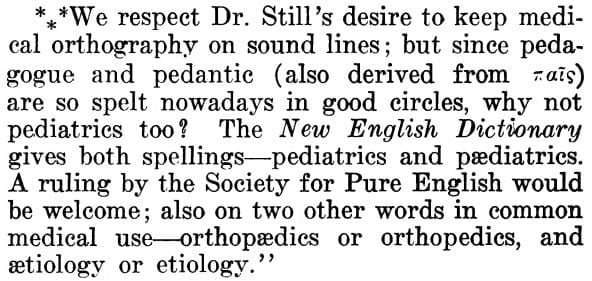George Frederic Still
Sir George Frederic Still KCVO (1868–1941) was an English paediatrician.
Described as the ‘father of British paediatrics’, Still wrote extensively on the paediatric population including works on congenital pyloric stenosis, infantile scurvy and congenital syphilis
First to describe a form of juvenile idiopathic arthritis (Still’s disease); a more typhoidal illness in adults (Still’s disease); a benign murmur (Still’s murmur) and ADHD.
A confirmed bachelor devoted to his mother, George Frederic Still dedicated his life to paediatrics. After retirement Still moved to Rhodesia refined his skills in flyfishing and wrote a book of Children’s poetry
Biography
- Born on February 27, 1868 in London
- 1888 – Achieved first class honours in the classical tripos (Bachelor of Arts) at Gonville and Caius’ College, Cambridge
- 1893 – Completed medical studies at Guy’s Hospital in London
- 1897 – Published doctoral thesis ‘on a form of childhood febrile arthritis‘ (today known as Still’s disease)
- 1899 – Physician for diseases of children to King’s College Hospital, London
- 1901 – Fellow of the Royal College of Physicians
- 1906 – Honorary professor of diseases of children at King’s, the first chair of paediatrics in England
- 1928 – Elected as the inaugural president of the British Paediatric Association
- 1937 – Knight Commander of the Royal Victorian Order (KVCO)
- Died on June 28, 1941
Medical Eponyms
Still’s disease (1896)
Still first described this form of juvenile idiopathic arthritis as a distinct disease, which was previously classified as rheumatoid arthritis in children. He presented 22 cases mostly from the Hospital for Sick Children, Great Ormond Street, with chronic elastic fusiform joint enlargement, splenomegaly, and enlargement of glands in a paper titled ‘On a form of chronic joint disease in children‘. [Still GF. 1896 Med-chir. Trans. 80, 47]
Still outlined that this disease differed from rheumatoid arthritis as there was a clinical absence of bony and osteophytic changes, presence of glands and spleen enlargement, and absence of cartilage changes on pathology.
Still’s murmur (1909)
Benign “twangy” (like a string being plucked) medium-to-long ejection systolic murmur, heard loudest at the left lower sternal border and apex. Also referred to as a ‘vibratory murmur’.
I should like to draw attention to a particular bruit which has somewhat of a musical character, but is neither of sinister omen nor does it indicate endocarditis of any sort. …its characteristic feature is a twangy sound, very like that made by twanging a piece of tense string… Whenever may be its origin, I think it is clearly functional, that is to say, not due to any organic disease of the heart either congenital or acquired.
Still GF. 1909
Controversies
Still was fluent in Greek, Latin, Hebrew and Arabic. In a Letter to the Editor of the British Medical Journal on in November 3, 1927 Still pointed out the Greek etymological derivation of Pædiatrics versus Pediatrics. The semantic connotations continue…
BMJ Editorial response
Major Publications
- Still GF. Some abnormal psychical conditions in children. The Goulstonian lectures. London: Lancet. 1902
- Still GF. Common disorders and diseases of childhood. London: Henry Frowde and Hodder and Stoughton. 1909. [Still’s murmur 434-435, 481.]
- Still GF. On a Form of Chronic Joint Disease in Children. Med Chir Trans. 1897;80:47-60.9
- Still GF. Clinical Lecture on infantile scurvy. Delivered at the Hospital for Sick Children, Great Ormond Street. Br Med J. 1906 Jul 28;2(2378):186-90
- Still GF. Congenital hypertrophy of the pylorus. Br Med J. 1923 Apr 7;1(3249):579-81
- Still GF. In durance vile. Journal of the Flyfishers’ Club 1924; 13: 46-8.
- Still GF. The Treatment of Infantile Scurvy. Proc R Soc Med. 1925; 18(Ther Pharmacol): 9-15
- Still GF. Pædiatrics or Pediatrics. Can Med Assoc J. 1929; 20(1): 84.
- Still GF. The History of Paediatrics. The Progress of the Study of Diseases of Children up to the End of the XVIIIth Century. Oxford University Press. 1931
- Still GF. Childhood and other poems. London: John Murray 1941
References
Biography
- Biography. George Fredrick Still. (1868-1941). JAMA. 1966 Jan 3;195(1):35.
- Birch CA. Still’s disease. George Frederick Still (1868-1941). Practitioner. 1973; 210(256): 307-308.
- Hamilton EB. George Frederic Still. Ann Rheum Dis. 1986 Jan; 45(1): 1–5.
- Farrow SJ. Sir George Frederick Still (1868-1941). Rheumatology (Oxford). 2006 Jun;45(6):777-8
- Dunn PM. Sir Frederic Still (1868–1941): the father of British paediatrics. Arch Dis Child Fetal Neonatal Ed. 2006; 91(4): F308–F310.
- Bibliography. Still, George Frederic Sir 1868-1941. WorldCat Identities
Eponymous terms
- Robbins A, Zhang G, Cadogan M. Name that murmur. LITFL 2022
- Cadogan M. Still’s murmur. Eponym A Day. Instagram
[cite]
Doctor in Australia. Keen interest in internal medicine, medical education, and medical history.



